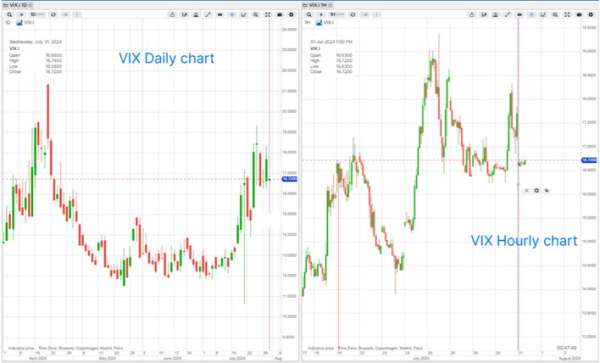Market on edge: Volatility in action: VIX, Microsoft and Meta earnings
Market on edge: Volatility in action - VIX, Microsoft- and Meta earnings
Current volatility scenario
Yesterday, we witnessed a notable surge in market volatility, which stands out compared to recent trends. This increase in volatility was somewhat anticipated, given the significant events lined up for this week. These events include major tech company earnings reports, a Federal Reserve press conference, and the release of unemployment data.
VIX movements
At market open yesterday, the VIX (Volatility Index) spiked quickly, surpassing the 18 mark. By around 19:00 Brussels time, the VIX had reached its peak for the day before settling back below 17. However, after-hours activity saw another surge. Microsoft's earnings report exceeded analyst expectations in most areas, but its Azure cloud business growth fell just short, rising by 29% compared to the expected 30%. This slight miss caused Microsoft's stock to drop by 7% after hours, driving the VIX back up to nearly 18. This reflects the current market nervousness, where even minor misses in expectations can lead to much larger volatility swings.

FOMC statement and interest rate decision
Adding to the volatility, the Federal Open Market Committee (FOMC) will release its statement and interest rate decision tonight, followed by a press conference. This event is a significant driver of market uncertainty, as investors await guidance on future monetary policy. The anticipation of the FOMC's decisions is keeping volatility high, with potential for a drop in the VIX if the outcome aligns with market expectations and provides clarity on the Fed's stance.
Microsoft earnings
Yesterday evening, Microsoft published its earnings report, which showed better-than-expected results in most areas. Key figures from the report include:
- Revenue: $64.7 billion, a 15% increase year-over-year.
- Operating Income: $27.9 billion, up 15%.
- Net Income: $22.0 billion, a 10% increase.
- Earnings Per Share (EPS): $2.95, up 10%.
The company’s cloud segment was a significant contributor, with Microsoft Cloud revenue reaching $36.8 billion, a 21% increase. However, despite these strong numbers, Microsoft’s stock fell in extended trading due to slightly lower-than-expected Azure revenue growth. Satya Nadella, Microsoft’s CEO, emphasized the company’s focus on innovation and customer trust, particularly in the AI space.
Meta earnings anticipation
This evening, Meta Platforms (META) is set to report its Q2 2024 earnings after the market closes. Analysts are expecting strong results, with projected revenue of around $38.37 billion, which would be a 20% increase from the same period last year. The expected earnings per share (EPS) is approximately $4.71.
Key factors to watch include the performance of Meta’s advertising business and updates on their AI initiatives, especially following the launch of their new AI model, Llama 3. Analysts are optimistic about the company’s growth, partly due to a healthy online advertising market and increased spending on Meta’s platforms.
Future volatility expectations
Will the volatility continue to rise? Could we see the VIX surpass 20? This is a question only time will answer. However, given the ongoing events and market reactions, it is plausible to expect heightened volatility in the short term.
VIX seasonality
It's important to consider VIX seasonality when analyzing volatility trends. Historically, the VIX tends to exhibit certain patterns throughout the year. Volatility often increases during earnings seasons and significant economic announcements. Additionally, the VIX tends to exhibit higher levels of volatility during certain months. For example, volatility often increases during the summer months and peaks in October, September, and November. This pattern is partly due to lower trading volumes in the summer and increased market activity in the fall. The "October effect" is a notable phenomenon where markets become more volatile due to various factors, including end-of-year positioning by institutional investors.
Daily expected moves
Another aspect to note is the significant increase in daily expected moves. For the SPX (S&P 500 Index), the expected move has jumped from 35 points to 57.97 points. Similarly, for the NDX (NASDAQ-100 Index), it has increased from 196.20 points to 301.12 points. These elevated expected moves underscore the heightened uncertainty and potential for significant price swings in the market.
Market update
At the time of writing, around two hours before market open, S&P 500 and Nasdaq futures show a possible rebound, with futures up 1.01% and 1.55% respectively after their nightly session. Microsoft is trading at -2.62% pre-market, compared to -7% yesterday evening.
Conclusion
Yesterday's market environment underscores the critical role of volatility in investment strategies. As we navigate through this period of higher-than-usual volatility, driven by key economic events and earnings reports, it is crucial for investors to stay informed and prepared for potential market swings. Understanding VIX seasonality and keeping an eye on daily expected moves can provide valuable insights for managing risk and capitalizing on market opportunities.
| Previous "Market on edge" updates |
|---|
|